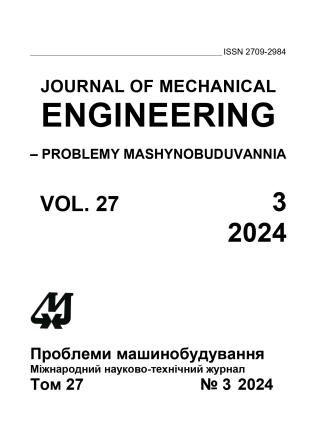Ітераційний метод визначення коефіцієнтів інтенсивності напружень при динамічному навантаженні системи тріщин
Аннотация
Розглянуто пружне ізотропне тіло у стані плоскої деформації, яке містить систему довільно розміщених тріщин під дією динамічного (гармонічного) навантаження. Автори поставили задачу – визначити поле напружень в околі тріщин в умовах їх хвильової взаємодії. Метод розв’язання ґрунтується на поданні переміщень у тілі у вигляді суперпозиції розривних розв’язків рівнянь руху, побудованих для кожної тріщини. З огляду на це вихідна задача приводиться до системи сингулярних інтегро-диференціальних рівнянь відносно невідомих стрибків переміщень на поверхнях тріщин. Для розв’язання цієї системи запропоновано новий ітераційний метод, який передбачає розв’язання на кожній ітерації сукупності незалежних інтегро-диференціальних рівнянь, що відрізняються тільки правими частинами. За нульове наближення обираються розв’язки, які відповідають окремим поодиноким тріщинам під дією динамічного навантаження. Такий новий підхід дозволяє уникнути труднощів, пов’язаних з необхідністю розв’язання систем інтегро-диференціальних рівнянь великої розмірності, що виникають при застосуванні традиційних методів. За результатами ітерацій отримані формули для розрахунку коефіцієнтів інтенсивності напружень для кожної тріщини. У частинному випадку чотирьох тріщин встановлено добре узгодження результатів, отриманих при безпосередньому розв’язанні системи восьми інтегро-диференціальних рівнянь методом механічних квадратур, і результатів, отриманих ітераційним методом. У цілому числові приклади демонструють збіжність і стійкість запропонованого методу у випадку систем досить великої кількості щільно розташованих тріщин. Досліджено вплив взаємодії між тріщинами на значення коефіцієнта інтенсивності напружень (КІН) в умовах динамічного навантаження. Важливим для механіки руйнування і новим результатом є виявлення абсолютного максимуму КІН нормальних напружень при деяких частотах осцилюючого нормального навантаження. На значення частот, за яких КІН сягають максимуму, і на максимальні значення впливають кількість взаємодіючих тріщин і конфігурація самої системи тріщин. Ці максимальні значення суттєво (у кілька разів) перевищують значення КІН поодиноких тріщин при аналогічному навантаженні. У той саме час в умовах статичного або низькочастотного навантаження можливе зменшення значень КІН порівняно з КІН для окремих тріщин. При зсувному навантаженні тріщин значення КІН дотичних напружень мають тенденцію до спадання при зростанні частоти, а їх значення несуттєво відрізняються від КІН для окремої тріщини.
Загрузки
Опубликован
Выпуск
Раздел
Лицензия
Copyright (c) 2024 О. І. Кирилова, В. Г. Попов

Это произведение доступно по лицензии Creative Commons «Attribution-NoDerivatives» («Атрибуция — Без производных произведений») 4.0 Всемирная.
Авторы, публикующиеся в этом журнале, соглашаются со следующими условиями:
- Авторы оставляют за собой право на авторство своей работы и передают журналу право первой публикации этой работы на условиях лицензионного договора (соглашения).
- Авторы имеют право заключать самостоятельно дополнительные договора (соглашения) о неэксклюзивном распространении работы в том виде, в котором она была опубликована этим журналом (например, размещать работу в электронном хранилище учреждения или публиковать в составе монографии), при условии сохранения ссылки на первую публикацию работы в этом журнале.
- Политика журнала позволяет размещение авторами в сети Интернет (например, в хранилищах учреждения или на персональных веб-сайтах) рукописи работы, как до подачи этой рукописи в редакцию, так и во время ее редакционной обработки, поскольку это способствует возникновению продуктивной научной дискуссии и позитивно отражается на оперативности и динамике цитирования опубликованной работы (см. The Effect of Open Access).

